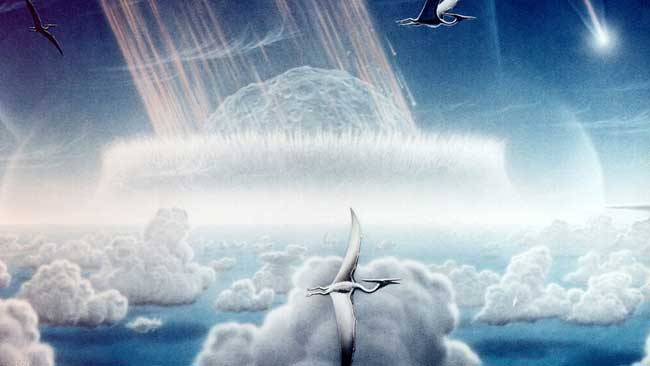
When the Chicxulub asteroid smashed into Earth 65 million years ago, the event drove an abrupt and long-lasting era of global warming, a new study reports. The results , published in the May 25 issue of Science, suggest that the asteroid impact caused a rapid temperature increase of 5 degrees Celsius (roughly 9 degrees Fahrenheit) that endured for about 100,000 years.
The monumental event, which caused the extinction of many animals including dinosaurs, is a rare case where Earth’s systems were perturbed at a rate greater than today’s global temperature changes driven by human activity. It therefore provides valuable insights into what may happen from sudden, extreme environmental changes, say the study’s authors.
Ken MacLeod of the University of Missouri, an author involved in the study, said “I think the impact and its aftermath is the single most spectacularly catastrophic event in Earth history.”
The effects of the impact on climate are still unclear, because Chicxulub disturbed many sediments worldwide. Scientists analyze layers of rocks, sediments and the shells of marine animals to understand past climates. These features of the geological record provide important clues about the environment, such as the abundance of atmospheric carbon dioxide, at the time each was deposited in the ground.[xyz-ihs snippet=”Adversal-468×60″]
MacLeod and his team discovered and analyzed a robust collection of well-preserved, sand grain-sized remains of fish teeth, scales and bone from El Kef in Tunisia that was buried around the time of the asteroid’s impact. These samples retain oxygen isotopic signatures that reveal the temperature at the time that the animals were alive.
The authors were able to collect samples from sediments that span the time leading up to the Chicxulub impact until long afterward. Based on their analysis, they propose that global temperatures abruptly increased at the time of the impact by about 5 C and did not cool to previous values for roughly 100,000 years.
“The clear [change in the geological record] we found suggests temperature change at the boundary was as dramatic as one could imagine,” said MacLeod, who compares it to the changes seen globally today.
“In less than two centuries, we’ve altered the composition of the atmosphere and reworked land surfaces on a global scale. The [perturbation from the Chicxulub impact] happened on human timescales or shorter, and the consequences of that perturbation, based on our data, lasted 100,000 years,” he said.
MacLeod cautioned that these results are derived from just one site in Tunisia, and more pristine geological samples are needed to better understand the full effects of Chicxulub. He has recently returned from another expedition to Mentelle Basin, off the southwest end of Australia, where the team gathered more samples representing this critical era. He is also working with other scientists to use computer modeling to understand atmospheric carbon dioxide concentrations at the time of the impact.
Source: AAAS


